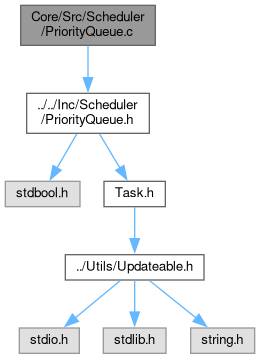#include "../../Inc/Scheduler/PriorityQueue.h"
Go to the source code of this file.
Functions | |
| void | PQInit (PriorityQueue *pq) |
| Initializes the priority queue. More... | |
| void | heapifyUp (PriorityQueue *pq, int index) |
| Restores the heap property by moving the node at the given index up. More... | |
| void | heapifyDown (PriorityQueue *pq, int index) |
| Restores the heap property by moving the node at the given index down. More... | |
| bool | PQPush (PriorityQueue *pq, Task task, int priority) |
| Pushes a task with a given priority onto the priority queue. More... | |
| bool | PQPop (PriorityQueue *pq, Task *task) |
| Pops the highest priority task from the priority queue. More... | |
| bool | PQPeek (PriorityQueue *pq, Task *task) |
| Peeks at the highest priority task in the priority queue without removing it. More... | |
| bool | PQIsEmpty (PriorityQueue *pq) |
| Checks if the priority queue is empty. More... | |
| bool | PQIsFull (PriorityQueue *pq) |
| Checks if the priority queue is full. More... | |
Function Documentation
◆ heapifyDown()
| void heapifyDown | ( | PriorityQueue * | pq, |
| int | index | ||
| ) |
Restores the heap property by moving the node at the given index down.
- Parameters
-
pq Pointer to the PriorityQueue structure. index The index of the node to move down.
Definition at line 29 of file PriorityQueue.c.

◆ heapifyUp()
| void heapifyUp | ( | PriorityQueue * | pq, |
| int | index | ||
| ) |
Restores the heap property by moving the node at the given index up.
- Parameters
-
pq Pointer to the PriorityQueue structure. index The index of the node to move up.
Definition at line 13 of file PriorityQueue.c.

◆ PQInit()
| void PQInit | ( | PriorityQueue * | pq | ) |
Initializes the priority queue.
- Parameters
-
pq Pointer to the PriorityQueue structure to initialize.
Definition at line 3 of file PriorityQueue.c.
◆ PQIsEmpty()
| bool PQIsEmpty | ( | PriorityQueue * | pq | ) |
Checks if the priority queue is empty.
- Parameters
-
pq Pointer to the PriorityQueue structure.
- Returns
- True if the queue is empty, false otherwise.
Definition at line 62 of file PriorityQueue.c.

◆ PQIsFull()
| bool PQIsFull | ( | PriorityQueue * | pq | ) |
Checks if the priority queue is full.
- Parameters
-
pq Pointer to the PriorityQueue structure.
- Returns
- True if the queue is full, false otherwise.
Definition at line 66 of file PriorityQueue.c.

◆ PQPeek()
| bool PQPeek | ( | PriorityQueue * | pq, |
| Task * | task | ||
| ) |
Peeks at the highest priority task in the priority queue without removing it.
- Parameters
-
pq Pointer to the PriorityQueue structure. task Pointer to the Task structure to store the peeked task.
- Returns
- True if a task was successfully peeked, false if the queue is empty.
Definition at line 56 of file PriorityQueue.c.

◆ PQPop()
| bool PQPop | ( | PriorityQueue * | pq, |
| Task * | task | ||
| ) |
Pops the highest priority task from the priority queue.
- Parameters
-
pq Pointer to the PriorityQueue structure. task Pointer to the Task structure to store the popped task.
- Returns
- True if a task was successfully popped, false if the queue is empty.
Definition at line 48 of file PriorityQueue.c.

◆ PQPush()
| bool PQPush | ( | PriorityQueue * | pq, |
| Task | task, | ||
| int | priority | ||
| ) |
Pushes a task with a given priority onto the priority queue.
- Parameters
-
pq Pointer to the PriorityQueue structure. task The task to push onto the queue. priority The priority of the task.
- Returns
- True if the task was successfully pushed, false if the queue is full.
Definition at line 41 of file PriorityQueue.c.
